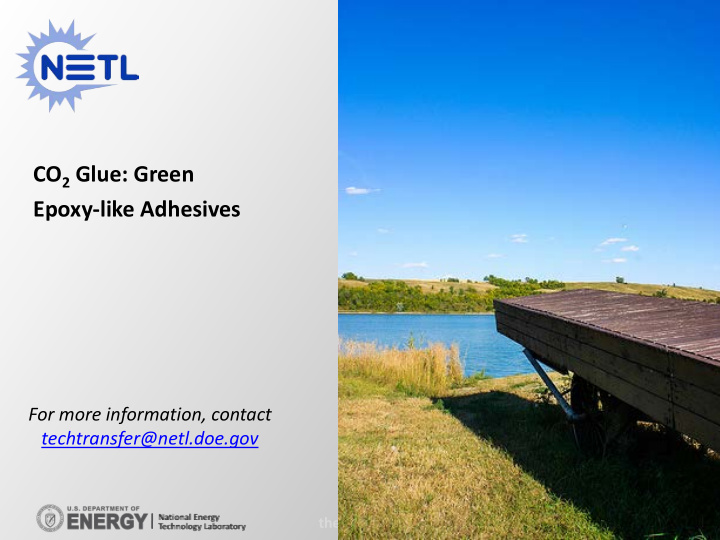



CO 2 Glue: Green Epoxy-like Adhesives For more information, contact techtransfer@netl.doe.gov the ENERGY lab
The Summary This adhesive is a "green," environmentally friendly epoxy that utilizes inexpensive CO 2 as a starting material, consists of composites that can be cured either thermally or with light, and has a scalable, high yield manufacturing process.
The Problem Problems with existing epoxies: • They create volatile emissions that are toxic • They require poisonous chemistries • They require environmentally nasty chemistries • They typically require a specific type of curing (toughening/ hardening in material creation process): either heat or light • They tend to be made from petrochemicals
The Solution: An Environmentally Friendly Superglue Excellent adhesive properties • – Exceptionally well with glass and metal Environmentally friendly • – No isocyanates – Solvent free – Uses CO 2 as one of its components Simple chemistry, using a mix and cure • method to create UV or thermal curing • Can be transparent or light yellow in • color Mixes well with silica gel • – Flow properties can be modified easily Made from the off the shelf, • commercially available components An environmentally friendly super glue • Should cost less to make •
The Opportunity • The global adhesives market estimated to be worth $21,527.0 million in 2010 and is expected to reach $28,659 million by 2016 1 • The specialty adhesives market is valued at $2.4 billion. 1. Global Adhesives and Sealants Market by Type, Applications, Trends, and Forecasts (2011-2016) 2. http://www.freedoniagroup.com/Specialty-Adhesives.html
The Opportunity The adhesive has potential for use in the following markets: Transportation: Marine, • Aerospace, Automotive – Glass and metal joints – New composites for automotives, aircraft, boats, and housing requires better adhesive/binder properties (decreases weight) Automotive manufacturers • Recreational sporting good • producers Electronics – anything with a • printed circuit board Military • Building materials •
The Process Thermal Curing Glass Adhesive Metal Adhesive Fiber Binder Simple Mixing Electronics Composites UV Curing CO 2 -based Precursor
Successful Adhesion Testing Perfomed • Used aluminum plates • Applied 1 square inch of adhesive (7-8 mg) • Fully suspended the plates with 125 lbs
Partnership Opportunity This technology is available for licensing and/or further collaborative research from the U.S. Department of Energy’s National Energy Technology Laboratory. For more information, contact techtransfer@netl.doe.gov
Recommend
More recommend